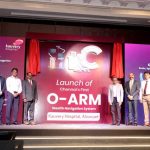SRM Global Hospitals, a leading multispecialty hospital in the city, successfully treated jaundice of a 78-year old end-stage pancreatic cancer patient from Bangladesh using a minimally invasive procedure known as choledochoduodenostomy, guided by an advanced endoscopic ultrasound technology. The cause of his jaundice was the obstruction of his bile duct by a tumour, leading to the accumulation of the bile. The procedure created a stent-supported new pathway between the bile duct and the duodenum (a part of the small intestine), paving the way for the bile to drain.
The main medical outcome of the procedure is the enhanced quality of life of the patient, who was suffering from loss of appetite, severe itching and sleeplessness. Besides, his palliative chemotherapy had to be stopped. However, following the procedure, the patient is able to have food to his heart’s content; and has found relief from severe itching and sleeplessness. The patient has gone back to his own country where he will undergo palliative cancer care.
According to Dr. N.A. Rajesh, Gastroenterologist, SRM Global Hospitals, who performed the procedure, the end-stage cancer patient developed jaundice, as a result of the tumour obstructing his bile duct. The patient lost his appetite and was unable to have food. He had complaints of severe itching and sleeplessness. Further, he could not continue with the chemotherapy treatment with jaundice. Considering the patient’s old age, and physical weakness, we opted for a minimally-invasive endoscopic procedure with the support of an advanced endoscopic ultrasound technology and created a surgical connection between the common bile duct and an alternative portion of the duodenum, a part of the small intestine, for the bile to drain. We have also used a newly developed stent (‘electro-cautery lumen apposing metal stent’) to strengthen the new pathway.
Dr Rajesh explained that the traditional treatment for this type of bile duct obstruction (medically, ‘malignant biliary obstruction’) is to place a self-expanding metallic stent through the naturally occuring opening of the bile duct in the duodenum. This is done by a procedure called Endoscopic Retrograde Cholangiopancreatography (ERCP). When ERCP is not possible, Percutaneous Transhepatic Biliary Drainage (PTBD) is done in which an external bag is temporarily fixed for the bile to drain and once the patient’s general condition improves, palliative biliary bypass surgery is done to re-route the flow of bile into the small intestine. However, the senior citizen with end-stage pancreatic cancer can hardly endure these demanding procedures. Besides, there is a risk of infection with PTBD, and the external bag can cause inconvenience for the patient. However, with the endoscopic ultrasound-guided Choledochoduodenostomy major surgical interventions and associated risks were avoided.
In his comments, Dr. P. Sathyanarayanan, President, SRM Group of Companies that the quality of life should be accorded a high priority even for the patients whose conditions cannot be cured. After this 30-minute procedure, the health condition of the patient improved dramatically with drastic reduction in jaundice and quick improvement in appetite. The itching stopped completely. The patient is back to his country where he will undergo palliative chemotherapy.
The endoscopic ultrasound-guided Choledochoduodenostomy is a recent modality. The main advantage is that it generates virtual images of internal organs using high-frequency sound waves, instead of video cameras. SRM Global Hospitals is one of the few centres in the country to perform the procedure which has high clinical success rates and low adverse events.









